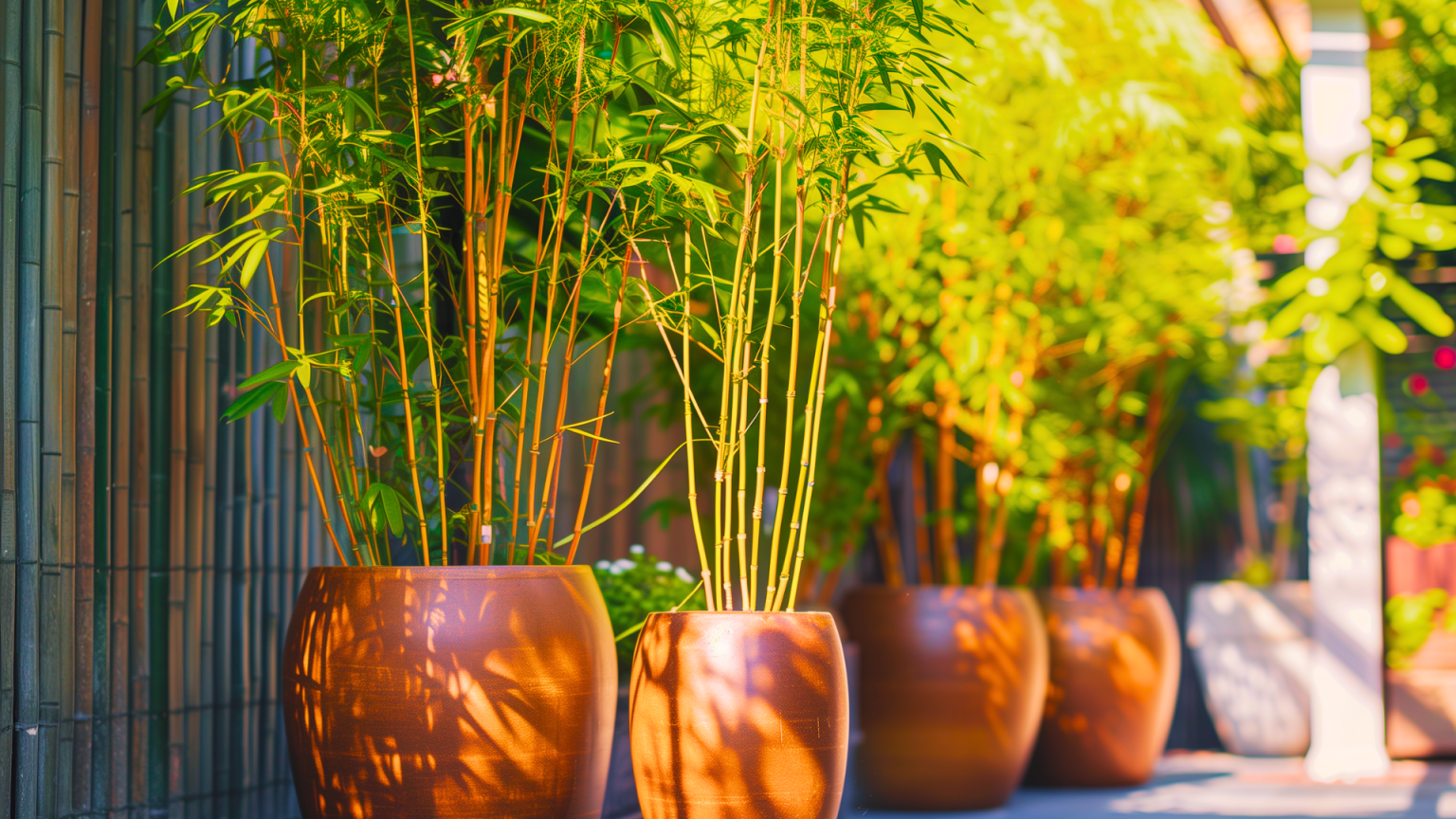How to Grow Japanese Bamboo Phyllostachys Aurea in Pots – The Perfect Statement Trees for Any Outdoor Space

How to Grow Japanese Bamboo Phyllostachys Aurea in Pots – The Perfect Statement Trees for Any Outdoor Space
Introduction
Japanese bamboo, specifically Phyllostachys Aurea, is a stunning addition to any garden or outdoor space. Its striking golden canes and graceful foliage make it a popular choice for those looking to create a serene and stylish atmosphere.
Selecting the Right Phyllostachys Aurea Bamboo for Pots
Choosing the right bamboo variety is the first step to success in container gardening. Phyllostachys Aurea, commonly known as Golden Bamboo, is known for its adaptability and ornamental appeal.
Identifying Phyllostachys Aurea and Its Characteristics
Phyllostachys Aurea is distinguished by its golden-yellow canes that turn a deeper shade as they mature. It can reach heights of up to 6 metres when grown in the ground, but in pots, its size is more manageable, making it ideal for container gardening.
Considerations for Height and Spread in Pots
When selecting a bamboo plant for your pot, consider the final height and spread of the plant. While Phyllostachys Aurea is relatively compact compared to other bamboos, it still needs adequate space to grow.
Why This Species is Ideal for Container Gardening
Phyllostachys Aurea is a clumping bamboo, meaning it grows in tight clusters, making it less invasive and more suitable for pots. Its resilience and adaptability also make it a great choice for beginners and experienced gardeners alike.
Choosing the Right Pot for Bamboo
Selecting the right pot is crucial for the health and growth of your bamboo. The pot must provide enough space for root growth and be made of a material that supports bamboo’s needs.
Recommended Pot Sizes for Bamboo Growth
For Phyllostachys Aurea, choose a pot that is at least 45 cm in diameter and depth. This allows sufficient room for the roots to spread and for the bamboo to reach its potential height.
Best Materials for Pots
Terracotta, ceramic, and wooden pots are excellent choices as they offer good insulation and support root growth.
Ensuring Proper Drainage to Prevent Waterlogging
Proper drainage is essential to prevent water from accumulating at the bottom of the pot, which can lead to root rot. Ensure that your chosen pot has multiple drainage holes.
Soil Requirements for Potted Bamboo
The right soil mix is vital for bamboo to thrive in a pot. Bamboo prefers well-draining, nutrient-rich soil that supports its rapid growth.
Ideal Soil Composition for Bamboo
A mixture of loam, sand, and organic matter creates an ideal environment for bamboo. This blend ensures good drainage while retaining enough moisture to keep the plant hydrated.
Planting Phyllostachys Aurea in Pots
Planting bamboo in pots requires careful preparation to ensure the roots establish well and the plant grows healthily.
Step-by-Step Guide to Planting Bamboo
-
-
Prepare the Pot: Fill the pot with the prepared soil mix, leaving enough room for the root ball.
-
Prepare the Bamboo: Gently remove the bamboo from its nursery pot, being careful not to damage the roots.
-
-
Plant the Bamboo
-
Place the bamboo in the centre of the pot, ensuring it stands upright. Fill in around the root ball with soil, pressing down gently to remove air pockets.
-
-
Water Thoroughly: Water the bamboo well after planting to help settle the soil around the roots.
-
Preparing the Roots for Container Growth
-
If the bamboo’s roots are tightly bound, carefully tease them apart to encourage new growth. This will help the bamboo establish itself more quickly in the new pot.
Positioning Bamboo for Optimal Sunlight
Bamboo thrives in full sun to partial shade. Place your pot in a location where the plant will receive at least 6 hours of sunlight each day.
Signs of Overwatering and Underwatering
Overwatering can lead to yellowing leaves and root rot, while underwatering may cause the leaves to curl and brown. Adjust your watering routine based on these signs to keep your bamboo healthy.
The Role of Humidity in Bamboo Health
Bamboo prefers a humid environment. If you live in a dry area, misting the leaves or placing a humidity tray under the pot can help maintain the necessary moisture levels.
Pruning and Maintenance of Potted Bamboo
Regular pruning is essential to keep your potted bamboo looking its best and to encourage healthy growth.
Importance of Regular Pruning
Pruning helps control the size of your bamboo, removes dead or damaged canes, and promotes air circulation within the plant, reducing the risk of pests and diseases.
Techniques for Maintaining Shape and Size
To maintain the desired shape, trim back the canes that are growing too tall or out of place. Use sharp, clean pruning shears to make clean cuts just above a node.
Removing Dead or Yellowing Culms
Regularly check for and remove any dead or yellowing culms (bamboo stalks) to keep the plant healthy and attractive. This also prevents disease from spreading.
Bamboo needs specific care depending on the season to thrive in a pot.
Managing Bamboo’s Natural Spreading Tendencies
Bamboo spreads via rhizomes, which can quickly fill a pot. Regular pruning of the roots and dividing the plant every few years will help control its size.
Using Barriers to Control Root Spread
If you’re worried about your bamboo outgrowing its pot, consider using a root barrier within the pot to limit the spread of the rhizomes. This can be as simple as a plastic barrier placed around the edge of the pot.
Ensuring the Bamboo Remains Healthy in a Confined Space
To keep your bamboo healthy in a pot, ensure it receives enough water, nutrients, and space for its roots to grow. Regularly check the pot for signs of overcrowding and repot when necessary.
Dealing with Pests and Diseases
Like all plants, potted bamboo can be affected by pests and diseases, but with proper care, these issues can be managed.
Common Pests that Affect Phyllostachys Aurea
Aphids, spider mites, and bamboo mites are common pests that can affect bamboo. Regularly inspect your plant for signs of infestation, such as discoloured leaves or webbing.
Identifying and Treating Diseases
Fungal infections, such as sooty mould, can affect bamboo if it is kept too wet. Ensure good air circulation around the plant and avoid overhead watering to reduce the risk of disease.
Natural Remedies for Pest Control
Neem oil, insecticidal soap can help control pest populations without harming the plant.
Repotting Bamboo: When and How
Repotting is an essential part of bamboo care
Signs That Your Bamboo Needs Repotting
If your bamboo’s roots are circling the inside of the pot it’s time to repot.
Safely Repotting Bamboo Without Damaging Roots
Gently remove the bamboo from its pot, being careful not to damage the roots. If the roots are tightly bound, you may need to gently loosen them before placing the plant in a new, larger pot.
Best Practices for Transitioning to a Larger Pot
Choose a pot that is at least 5-10 cm larger in diameter than the current one. After repotting, water the bamboo well and place it in a shady location for a few days to help it recover from the shock.
Displaying Bamboo in Your Outdoor Space
Potted bamboo offers a range of creative possibilities for enhancing your garden or outdoor space.
Creative Ways to Place Bamboo Pots
Place bamboo pots along walkways, in corners, or as focal points in your garden or simply fencing your garden, their tall, slender form adds height and structure to your design.
Using Bamboo to Create Privacy Screens
Potted bamboo can be used to create natural privacy screens on patios or balconies. Arrange the pots in a row to form a living wall that provides both beauty and seclusion.
Pairing Bamboo with Other Plants for Aesthetic Appeal
Combine bamboo with other plants, such as ornamental grasses or flowering perennials, to create a layered and dynamic garden design. The contrast between the bamboo’s vertical form and the other plants’ textures can be stunning.
Benefits of Growing Bamboo in Pots
There are numerous advantages to growing bamboo in pots, making it an excellent choice for many gardeners.
Flexibility and Mobility in Your Garden
Potted bamboo can be easily moved around to change the layout of your garden or to protect the plant from harsh weather conditions.
Enhancing Outdoor Spaces with Elegant Greenery
Bamboo’s unique appearance and graceful movement in the wind add a touch of elegance and tranquillity to any outdoor space, making it an ideal choice for zen gardens and modern landscapes.
Common Mistakes to Avoid
Avoiding common pitfalls will ensure your potted bamboo remains healthy and vibrant.
Overwatering and Poor Drainage Issues
One of the most common mistakes is overwatering bamboo. Ensure your pot has adequate drainage and that you allow the top layer of soil to dry out between waterings.
Choosing the Wrong Pot Size or Material
Selecting a pot that is too small or made of a material that doesn’t support bamboo’s growth can hinder its development. Choose a pot that allows room for growth and is made of a durable material.
FAQs
How long can bamboo Phyllostachys Aurea live in pots?
Phyllostachys Aurea can thrive in pots for many years if properly cared for. Regular repotting, proper watering, and seasonal care will ensure its longevity.
Can bamboo Phyllostachys Aurea survive winter in pots?
Yes, bamboo Phyllostachys Aurea can survive winter in pots.
How do I prevent my potted bamboo from becoming root-bound?
Regularly repot your bamboo every 2-3 years, or prune the roots if necessary, to prevent it from becoming root-bound.
Does bamboo need direct sunlight?
Bamboo thrives in direct sunlight but can also tolerate partial shade.
How often should I water my bamboo in a pot?
Water your bamboo regularly during the growing season, keeping the soil consistently moist. In winter, reduce watering but do not let the soil dry out completely.
Can I grow bamboo Phyllostachys Aurea indoors? See my next up coming blog
While Phyllostachys Aurea is best suited for outdoor growth, it can be grown indoors if provided with enough light and humidity. Choose a large pot and place it near a bright window.
Conclusion
Growing Japanese bamboo Phyllostachys Aurea in pots is a rewarding and visually stunning way to enhance your outdoor space. With the right care, including proper pot selection, soil preparation, watering, and seasonal attention, your bamboo will thrive and bring a touch of elegance to your garden. Whether you’re looking to create a zen garden or simply want to add some vertical interest, potted bamboo is the perfect choice. Start your bamboo-growing journey today and enjoy the beauty and tranquillity it brings to your outdoor environment.

